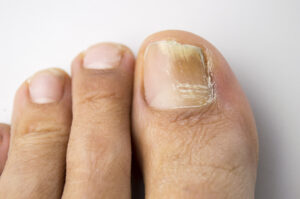Podiatrist in Plano, TX, Explains How Nail Fungus is Treated
 Nail fungus is caused by tiny microscopic fungi. They enter the body through small cuts in your skin and infect your toenails, which may not be noticeable in the beginning. However, over time, the fungi grow, making your toenail thick and discolored. Fungus can also spread to the skin, leading to a painful infection. Left untreated, your toes may hurt and the pain may make it difficult to walk. Treating this condition is critical — our podiatrist in Plano, TX, explains more below.
Nail fungus is caused by tiny microscopic fungi. They enter the body through small cuts in your skin and infect your toenails, which may not be noticeable in the beginning. However, over time, the fungi grow, making your toenail thick and discolored. Fungus can also spread to the skin, leading to a painful infection. Left untreated, your toes may hurt and the pain may make it difficult to walk. Treating this condition is critical — our podiatrist in Plano, TX, explains more below.
Symptoms of Fungal Nails
The most obvious signs of fungal nails include discoloration and thickening of the nail. There may also be pain or redness around the affected nail. People commonly hide the problem with closed-toe shoes or nail polish, but it is important to get the root of the problem treated. Home treatments may work for some people, but many cases of toenail fungus require stronger treatments.
Diagnosing Fungal Nails
Our podiatrist will evaluate your nails for signs of fungus and possibly test the type of fungus causing the infection — psoriasis or other conditions involving yeast and bacteria can mimic a fungal infection of the nail. Once we know the cause of your infection, we will be able to determine the best course of treatment for you.
Treatment Options
Nail fungus is sometimes treatable with at-home care. However, some cases may be severe enough to require other treatment options, so talk with our podiatrist if over-the-counter methods haven’t worked to resolve your problem. Other treatments that may be recommended by our podiatrist include:
- Antifungal drugs — medications that are either taken orally or applied directly to the nail to clear a fungal infection.
- Medicated nail polish — this is painted onto the infected nail and surrounding skin every day. After seven days, you remove the polish and repeat the process.
- Medicated nail cream — our podiatrist may prescribe an antifungal cream to rub into your nail.
Infections can recur, so it will be important to take preventive measures after your treatment is complete, such as keeping your feet clean and dry. These treatments and preventive measures help most people, but some fungal nail infections don’t respond to medicine. Our podiatrist will discuss next steps if this is the case for you.
Contact Our Podiatrist in Plano, TX, Today To Learn More!
The information provided in this article is not meant to be medical advice and is for educational purposes only. If you would like to learn more about hammertoe and other topics related to podiatry, feel free to contact Dallas Podiatry Works, with a convenient podiatry office in Plano, TX, by calling 972.564.8556 or by clicking here.

 Nail fungus is caused by tiny microscopic fungi. They enter the body through small cuts in your skin and infect your toenails, which may not be noticeable in the beginning. However, over time, the fungi grow, making your toenail thick and discolored. Fungus can also spread to the skin, leading to a painful infection. Left untreated, your toes may hurt and the pain may make it difficult to walk. Treating this condition is critical — our podiatrist in Plano, TX, explains more below.
Nail fungus is caused by tiny microscopic fungi. They enter the body through small cuts in your skin and infect your toenails, which may not be noticeable in the beginning. However, over time, the fungi grow, making your toenail thick and discolored. Fungus can also spread to the skin, leading to a painful infection. Left untreated, your toes may hurt and the pain may make it difficult to walk. Treating this condition is critical — our podiatrist in Plano, TX, explains more below.


